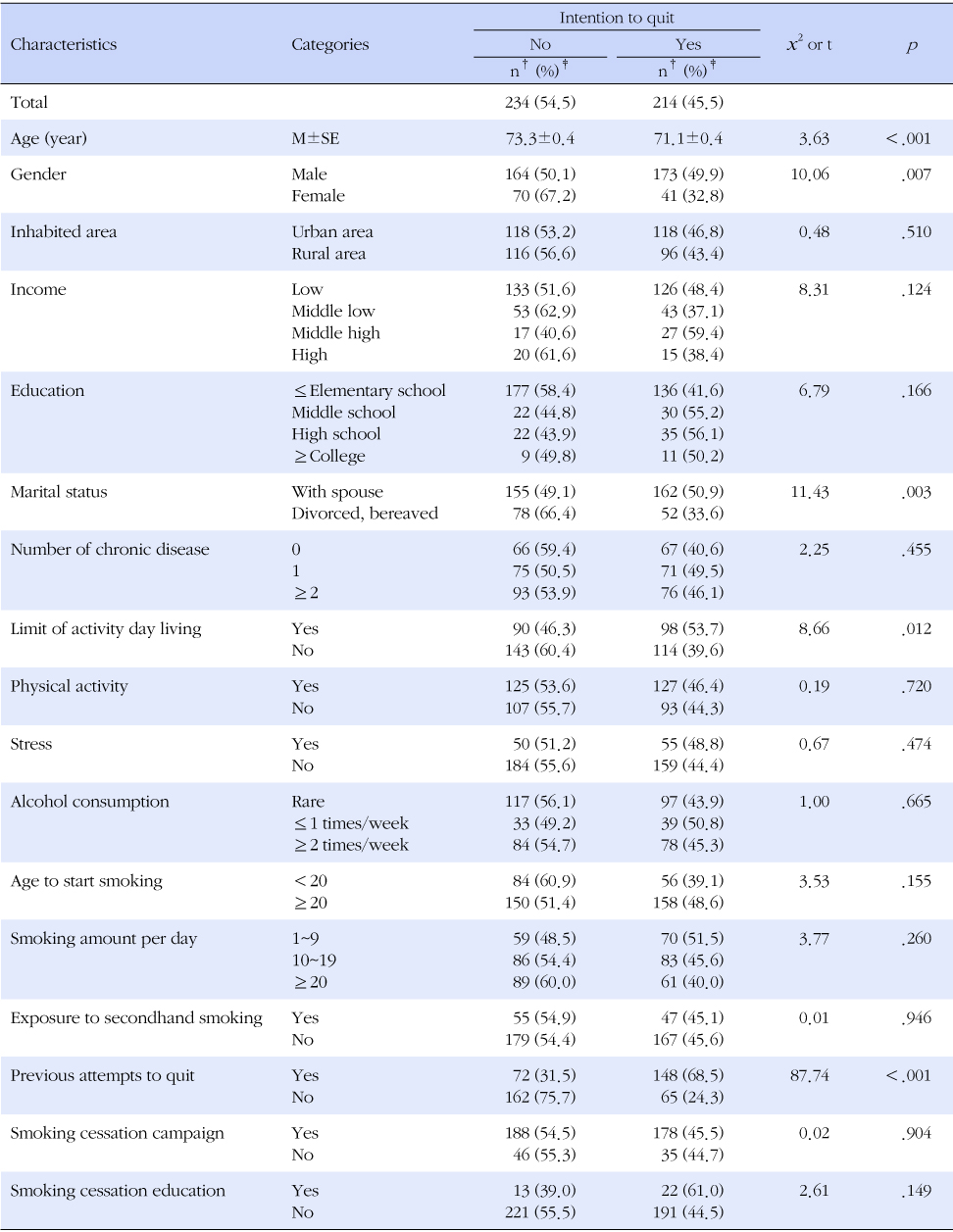References
1. Abdullah AS, Ho LM, Kwan YH, Cheung WL, McGhee SM, Chan WH. Promoting smoking cessation among the elderly: What are the predictors of intention to quit and successful quitting? J Aging Health 2006. 18(4)552–564.
2. Appel DW, Aldrich TK. Smoking cessation in the elderly. Clin Geriatr Med 2003. 19(1)77–100.
3. Cataldo JK. Smoking and aging: Clinical implications. Part 1: Health and consequence. J Gerontol Nurs 2003. 29(9)15–20.
4. Cataldo JK. Clinical implications of smoking and aging: Breaking through the barriers. J Gerontol Nurs 2007. 33(8)32–41.
5. Chaaya M, Mehio-Sibai A, El-Chemaly S. Smoking patterns and predictors of smoking cessation in elderly populations in Lebanon. Int J Tuberc Lung Dis 2006. 10(8)917–923.
6. DiClemente CC, Prochaska JO, Fairhurst SK, Velicer WF, Velasquez MM, Rossi JS. The process of smoking cessation: An analysis of precontemplation, contemplation, and preparation stages of change. J Consult Clin Psychol 1991. 59(2)295–304.
7. Feng G, Jiang Y, Li Q, Yong HH, Elton-Marshall T, Yang J, et al. Individual-level factors associated with intentions to quit smoking among adult smokers in six cities of china: Findings from the ITC china survey. Tob Control 2010. 19Suppl 2. i6–i11.
8. Hyland A, Borland R, Li Q, Yong HH, McNeill A, Fong GT, et al. Individual-level predictors of cessation behaviors among participants in the International Tobacco Control (ITC) Four Country Survey. Tob Control 2006. 15Suppl 3. iii83–iii94.
9. Kerr S, Watson H, Tolson D, Lough M, Brown M. Smoking after the age of 65 years: A qualitative exploration of older current and former smokers views on smoking, stopping smoking and smoking cessation resources and services. Health Soc Care Community 2006. 14(6)572–582.
10. Kerr S, Watson H, Tolson D, Lough M, Brown M. An exploration of the knowledge, attitudes and practice of members of the primary care team in relation to smoking and smoking cessation in later life. Prim Health Care Res Dev 2007. 8(1)68–79.
11. Kim DH, Suh US. Smoking as a disease. Korean J Fam Med 2009. 30(7)494–502.
12. Kim JG. The impact of family type on health behavior of elderly people. J Welf Aged 2011. 5135–55.
13. Korea Centers for Disease Control and Prevention. The Fourth Korea National Health and Nutrition Examination Survey [KNHANES IV-3] 2010. 12. Retrieved August 22, 2011. from
http://knhanes.cdc.go.kr/.
14. Korea National Statistical Office. Census of elderly population in Korean 2010 year 2010. 10. Seoul: Author;
15. Lam TH, Li ZB, Ho SY, Chan WM, Ho KS, Tham MK, et al. Smoking, quitting and mortality in an elderly cohort of 56,000 Hong Kong Chinese. Tob Control 2007. 16(3)182–189.
16. Marques-Vidal P, Melich-Cerveira J, Paccaud F, Waeber G, Vollenweider P, Cornuz J. Prevalence and factors associated with difficulty and intention to quit smoking in switzerland. BMC Public Health 2011. 11227.
17. Myung SK, McDonnell DD, Kazinets G, Seo HG, Moskowitz JM. Relationships between household smoking restrictions and intention to quit smoking among Korean American male smokers in California. J Korean Med Sci 2010. 25(2)245–250.
18. Park SM, Son KY, Lee YJ, Lee HS, Kang JH, Lee YJ, et al. A preliminary investigation of early smoking initiation and nicotine dependence in Korean adults. Drug Alcohol Depend 2004. 74(2)197–203.
19. Rusanen M, Kivipelto M, Quesenberry CP Jr, Zhou J, Whitmer RA. Heavy smoking in midlife and long-term risk of alzheimer disease and vascular dementia. Arch Intern Med 2011. 171(4)333–339.
20. Runciman P, Watson H, McIntosh J, Tolson D. Community nurses' health promotion work with older people. J Adv Nurs 2006. 55(1)46–57.
21. Ryu SY, Shin JH, Kang MG, Park J. Factors associated with intention to quit smoking among male smokers in 13 communities in Honam region of Korea: 2010 Community Health Survey. Korean J Health Educ Promot 2011. 28(2)75–85.
22. Sachs-Ericsson N, Schmidt NB, Zvolensky MJ, Mitchell M, Collins N, Blazer DG. Smoking cessation behavior in older adults by race and gender: The role of health problems and psychological distress. Nicotine Tob Res 2009. 11(4)433–443.
23. Schofield I, Kerr S, Tolson D. An exploration of the smoking-related health beliefs of older people with chronic obstructive pulmonary disease. J Clin Nurs 2007. 16(9)1726–1735.
24. Suh KH. Updates in the smoking and smoking cessation of Korean women. Korean J Health Psychol 2007. 12(4)695–713.
25. Son GY. Analysis of influencing factors on elderly smoker's smoking-cessation intention based on theory of planned behavior 2010. Daegu: Keimyung University; Unpublished master's thesis.

